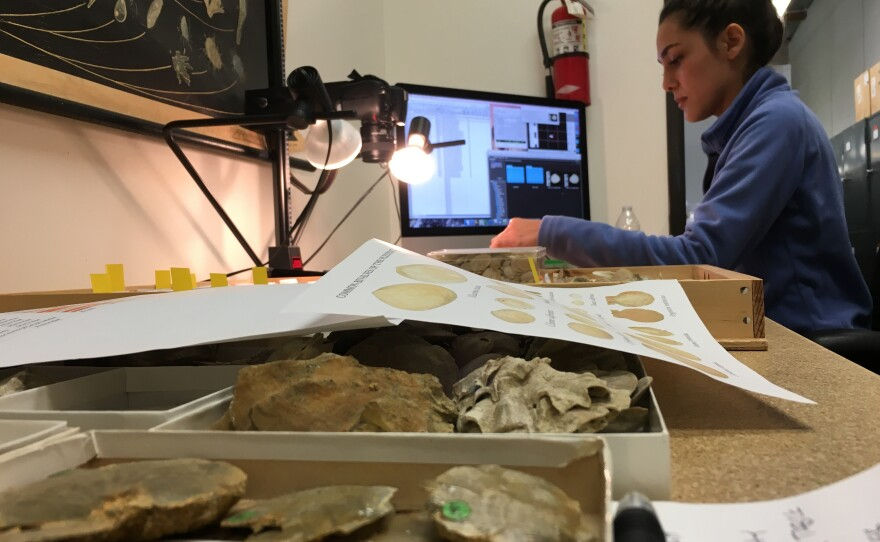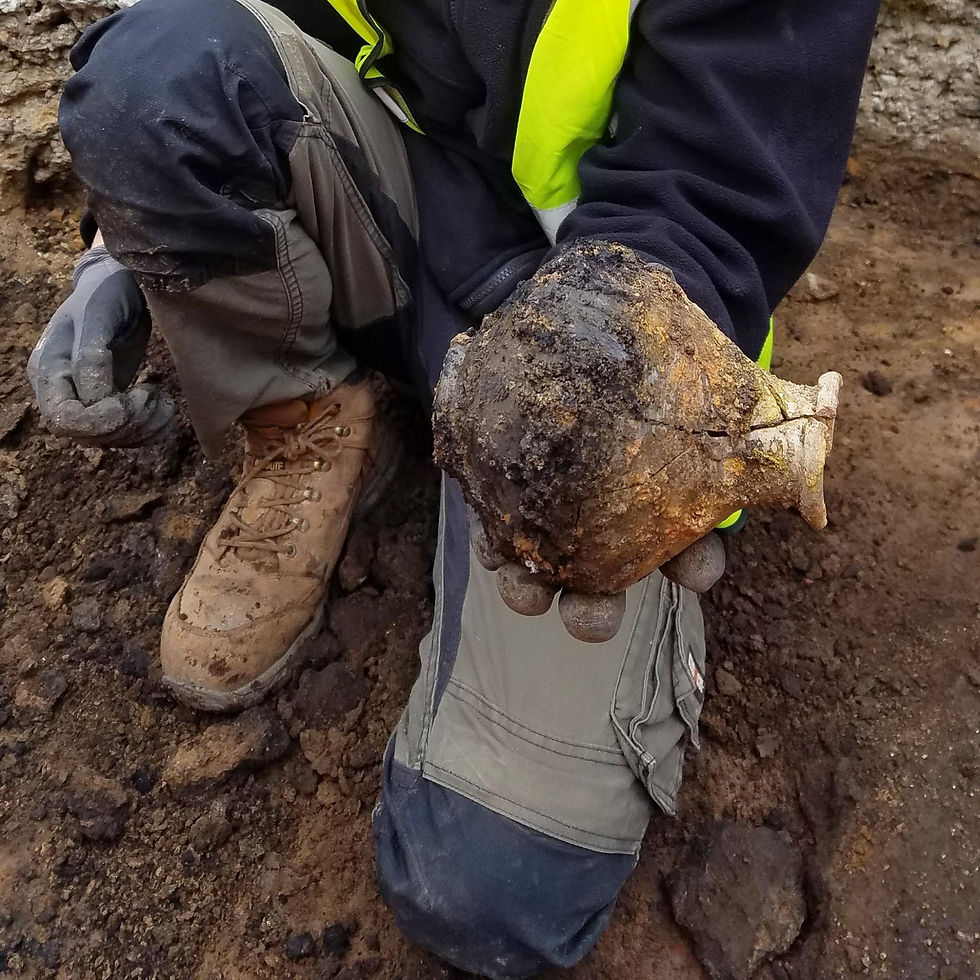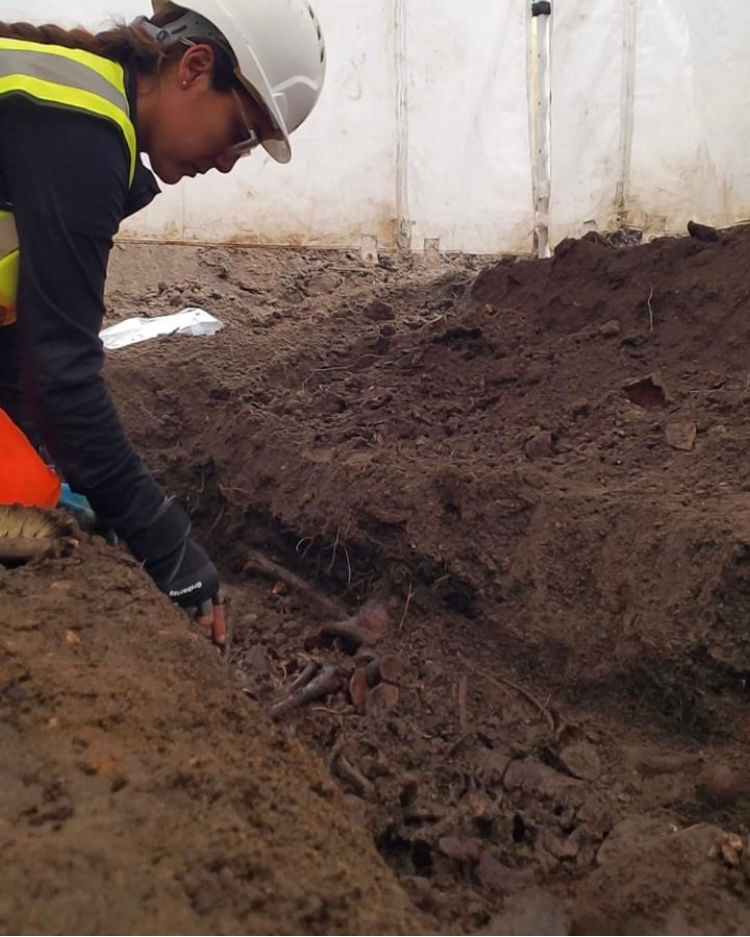Archaeology isn't just about digging up artifacts; it's an enthralling journey into unraveling the mysteries of our past. As archaeologists, we're explorers of human history, piecing together narratives from fragments of ancient civilizations.
⛏️ By understanding our history through archaeological discoveries, we gain insight into the human journey, fostering connections between ancient civilizations and our modern society.
Let's celebrate the fascinating work of archaeologist, with this interview of Cambria Rodriguez!

My name is Cambria Rodriguez and I am an archaeologist! (no, I do not study Dinosaurs, sorry!) Archaeologists study people who lived in the past through the material remains they leave behind-anything from their rubbish to skeletal remains can give great insight into how humans from the past lived. Because archaeologists study such a vast time of history and varied artifacts, many have specialisms. My specialist training is in osteology, the study of human bones, and my area of focus is Mexico, particularly, the Aztec Empire which ancient ruins lie beneath today’s Mexico City.
I grew up just south of Los Angeles, California but have been living and working around the world the past seven years going wherever my career takes me! Majority of that time, I have been living in London, England. Currently, I am completing my PhD in Archaeology at University College London. My research uses biomolecular, osteological, and archaeological analysis to reconstruct the lives of children ritually killed in the Aztec Empire. Historically, the study of ancient Mesoamerican civilizations have heavily relied on colonial interpretations which have not always been accurate. I hope this project will transform the way researchers engage with colonial ethnohistory while decolonizing the voices of children lost in ancient history.
My missions
My role as an archaeologist is to excavate, interpret, and preserve material recovered from historical sites in order to better understand how past people lived and died. It is very important we are familiar with how our society has transformed to what it is today from our ancestors and learn from their mistakes and triumphs. Archaeological research helps us understand pivotal social facets including disease, climate change, and technological development. An archaeologists' role is to educate others about the historical record whether it be in a classroom, doing fieldwork, a museum collection, or in the political sphere. There are many career paths open to archaeologists.

I have worked in many different types of jobs in the field including teaching university courses, field archaeologist, and museum curator. I have been lucky enough to have worked in various museum collections around the world including the Natural History Museum of Los Angeles (NHMLA), Bernice Pauahi Bishop Museum of Hawaii, The National Gallery of Victoria in Australia, and The British Museum in London. In my most recent role as a curator, I analyzed and interpreted material from a site that was occupied for over 3,000 years in Essex, England. Our mission was to make the material accessible to the public and ready for research. I worked on curating and digitizing the artifacts onto an online database and moving the material in collection-safe storage that will prevent degradation of the artifacts over time so future generations can continue to access it.
Our mission was to make the material accessible to the public and ready for research.
I think it is extremely important to make museums and the material within accessible to the public and greater academic community. In the past nine years, I am fortunate enough to have worked on more than one project aimed at digitizing collections. In the majority of the United States, museums are not free and out of budget for the average family. It brings me great joy that with my work, people can view artifacts and learn from them in the comfort of their own home anywhere in the world.
I always get asked what my favorite find is or the coolest thing I’ve seen. Unfortunately, I haven't found a crystal skull or treasure of gold bricks. My favorite experience as an archaeologist was working at Manzanar National Historic Site in California. A former World War II Japanese relocation camp, the team conducted restorative archaeological excavations in collaboration with the descendant communities to uncover features that will help learn more about the site’s full history. One season, I helped excavate a hideout that was constructed by a resident beneath his bungalow home to hide from guards and hang out with friends. In the secret basement, people gathered to hide from harsh realities and socialize without restrictions. We found an array of artifacts including sake bottles and marbles but what made the experience special was working with the living grandson of the man who built the hideout. It is unique for an archaeologist to work with living family members. It is a personal and rewarding encounter I hope every archaeologist gets to have. Being able to uncover his grandfather’s experiences made the project more meaningful and helped me feel connected to past experiences. Seeing his tears of joy and gratification for our work was priceless. The excavation forever changed the way I carried out my work.

Archaeology to better understand the past
You’d think in today’s modern world we would know everything by now! but the truth is, there is still SO much we do not know about our species and how civilisations have evolved. Human history is just beneath our feet, quite literally, and archaeologists are important in piecing together our enigmatic past and preserving history for generations to come.
Human history is just beneath our feet, quite literally (...)
I began my academic career studying history and global politics. I have always had an interest in Latin American and Indigenous history. Growing up I found it frustrating that I did not know much about my ancestors and struggled with my own identity. Born and raised in California, which has the largest Mexican American population in the United States, the history of my ancestors never made it into the curriculum. Until attending college, I relied on the oral histories of my grandmother to learn more about my heritage. While doing my undergraduate research, I realized Instead of writing about the past, I wanted to be out in the field actively working to piece together the unknown and that is my favorite part of being an Archaeologist. Unfortunately, that also is my least favorite part! A lot of people do not realize that excavation is extremely physical. In addition to endless research, It takes a lot of manual labor and sometimes, you don’t find anything at all!
There are many different types of archaeology that can lead to employment by a range of organizations. The four main areas are:
specialist archaeology: specializing in particular geographic areas, historic periods, or types of objects such as pottery, coins, or bones.
research/academic archaeology: applying for funding and grants to work on sites or survey projects over several months or years.
public archaeology: work carried out by professional organizations with public involvement.
commercial/contract archaeology: working for a developer who is responsible for the cost and time involved in a project.

Working on projects in commercial archaeology can take time, and require a large team depending on the size and scale of the project. In most countries, it is a legal requirement for building planners to have archaeologists survey the land before construction. Initially, historic research on the area of building interest is carried out to determine what or who occupied the area in the past. Then “test pits” or “trial trenches” are methodically dug during the evaluation phase to determine the archaeological potential of the site. If the site proves potential, we then carry out full-blown excavation. Because we are working alongside the building and development industry, we are usually under contract to complete the project with a strict deadline which means working year-round in ALL weather conditions! Yes, it can be brutal. Digging and recording in the rain, snow, or heat is not ideal and working on a construction site requires wearing protective gear including steel-cap boots, helmets, safety glasses, gloves, and hi-vis clothing which could make the physical aspect of work a bit uncomfortable. Excavations also require A LOT of paperwork! It’s very important for post-excavation research to record every layer, feature, soil type, and find accurately and with detail. Following excavation, everything is sent to the post-excavation and archival team for processing. Each artifact and bone, human or animal, is cleaned and digitally logged. Soil samples are also logged and a team of specialists review the material including archaeo-botanists, geo-archaeologists, osteologists, zoo-archaeologists, and more. A final report of our work and findings is written and sent to the developer and usually a public body that looks after the historic environment. In the UK, Historic England is the government's statutory advisor.
(We work) year-round in ALL weather conditions!
This entire process could take a few days, weeks, months and even years depending on the size and scale of the site. I once worked on a site that was supposed to be completed in six months. It took nearly two years! We could not stop finding Roman structures, burials, and objects. Although preliminary research is done to determine the archaeological potential of the area, you can never be prepared for what you may or may not find.

My background
Since I was a child it was a dream to be the first in my family to attend graduate school and get my PhD. My parents weren’t lucky enough to get a college education and they’ve worked incredibly hard to help me get the education I have today. I have six college degrees thus far and have been going back to university on-and-off for over ten years now. I love learning THAT much! I wanted to have my PhD by the time I was 30 years old… That’s not happening! It’s okay when things don’t work out the way you plan and it's okay to go at your own pace. Do not compare your journey to others. Good things take time and It is important you enjoy and take advantage of every moment in the process. One reason why my educational journey has been a long process is because I have never ever turned down an opportunity for growth. Not only have I worked around the world and studied abroad, I also worked for the United States Government, given a place in the US Peace Corps, been offered to do research in Tanzania, attended field school in Spain, and so much more. It has not been an easy journey and I have sacrificed a whole lot to get to where I am today. There’s nothing I miss more than my family and friends back home but I’ve learned to become a stronger person on my own. I encourage people to volunteer and get involved before committing to a career path. Make sure you are absolutely in love with what you want to do for the rest of your life!
It was a dream to be the first in my family to attend graduate school and get my PhD

After completing my PhD, I intend to do more work in Mexico and publish my research in both English and Spanish languages. I would like to continue my work within the heritage sector and work in directorial roles in museums. I have an interest in repatriation projects, equal opportunities for minority peoples and providing equal access to education. I am excited to see where my career takes me next!

My experience as a woman in archeology
While working in commercial archaeology alongside the construction industry I was surrounded by men all the time, man-splaining to me how to use a shovel, asking “Do you need help with that, love?”, challenging my career choice, I’ve heard it all! My experience inspired me to create my instagram account, ‘Big Dig Energy’ to bring awareness to the struggles of females working in science and share my personal experiences in the field. More women are becoming vocal in advocating for change in the workplace. Over the last five years I have seen a boom in women working and dominating in the field of archaeology. I look forward to the future and what the new generation will bring to the table.

Role model
Growing up I did not know what a successful female archaeologist looked like and it’s hard to be what you can not see. Archaeology seemed like a fantasized job that only men with whips and good looks could achieve. My role models are everyday women in various industries that wake up every morning and make an effort to get out of bed and get out the door, afterall, that is the hardest part of the day and the first step in making a difference. I am lucky to have many hard-working people in my life that inspire me everyday. I hope that I can become the role model for young aspiring archaeologists that I wished to see growing up.
My role models are everyday women (...) that wake up every morning and make an effort to get out of bed and get out the door.
Left. My very first excavation at Manzanar National Historic Site, a former WWII Japanese Relocation Camp.
Right. Excavating the children’s orphanage at Manzanar National Historic Site. I was able to bring my younger brother and friend along to experience a day in my shoes.
Polynesian dance
I love giving back to the community and I have a passion for Polynesian dance. I’ve performed for entertainment companies throughout Los Angeles, Las Vegas, and Hawaii, and was an instructor at a dance studio. When I was 18 years old I fused my passions for public service and dance together and formed my own non-profit Polyneisan dance group, The Hula Dollz. I taught girls and boys of all ages in my community the art and cultures of polynesia and its unique dance styles. We performed for local charities, hospitals, retirement homes, schools, birthday parties, and more. We held an annual luau to raise money for apparel, implements, and production equipment. Dance is my escape and there’s nothing more gratifying than using my passion to make someone smile. Unfortunately, since moving to London, I haven’t been warm enough to put my coconuts back on!
You can view some of my dance videos here! https://www.youtube.com/watch?v=gTc8kliiYrc
Work life balance
Unfortunately, If you are a woman in science you are likely underpaid and overworked! I am a huge advocate for maintaining a good work-life balance. I want to work to live, not live to work! I am very well organized and set reasonable short-term goals for myself to help balance my workload. On weekends I completely shut off from work and refuse to look at emails outside of work hours. Doing this gives my undivided attention to family, friends, and my own self-care. It's important for your sanity to set boundaries, prioritize, and avoid burn-out. I love to travel and at the beginning of every year I like to plan my holidays so I always have something positive to look forward to. This year I plan to visit Portugal, Germany and possibly Egypt! For my PhD research I will need to travel to France and Mexico as well.
Some pieces of advices
I have had a lot of people second-guess my career choice and ability to succeed which has made me suffer from imposter-syndrome and lack of confidence in myself. Some of my own family members have told me to choose a different path, one that would “make money”. I was even told by my undergraduate department director to quit some of my side jobs if I wanted to succeed as a full-time student. I didn’t take his advice and graduated with honors as a full-time student and working full-time.
Looking back, I would remind my younger self to continue to do what makes her happy.
Speak up for yourself and others and surround yourself with people that encourage you to do better.

My undergraduate research won first place at the California State University Student Research Competition. The research was my first published work and can be read here: https://journals.calstate.edu/tthr/article/view/2671
Edited by Mazzarine D.
Find her here: Instagram: @_bigdigenergy
Articles on Cambri's work ! 🤗
Cambria RODRIGUEZ: unraveling the secret of our past






コメント